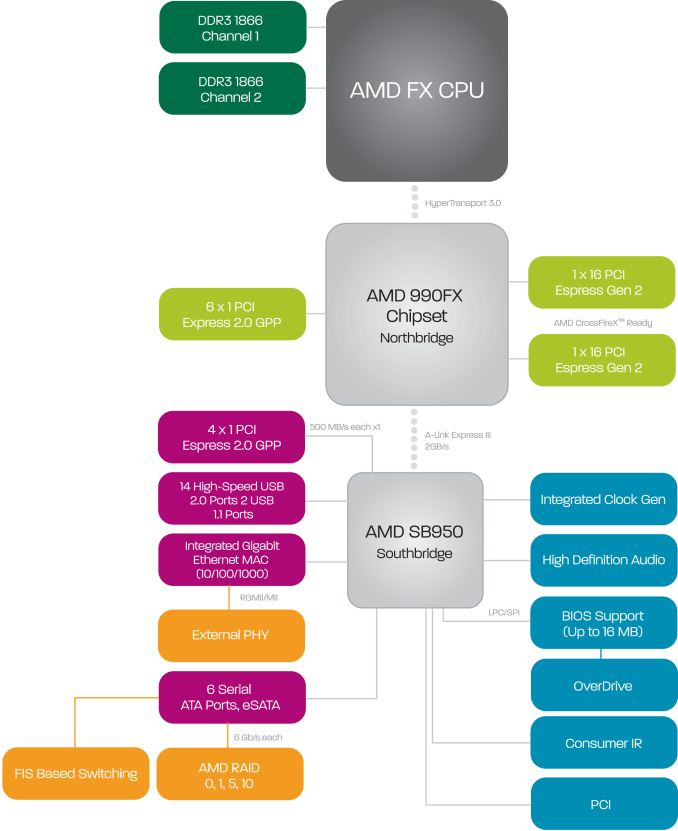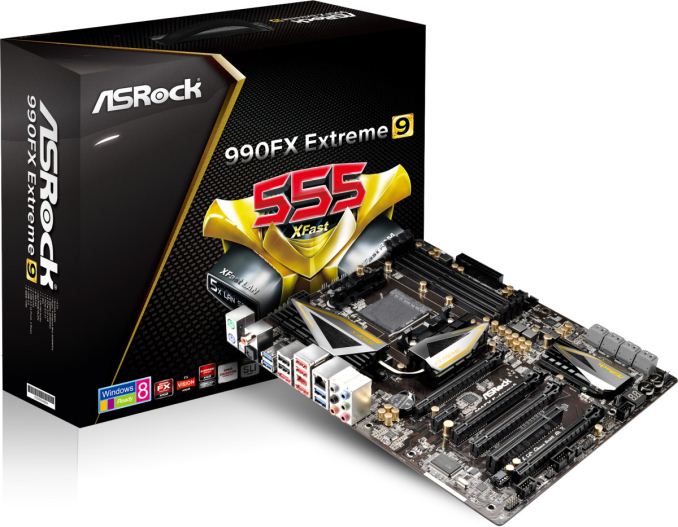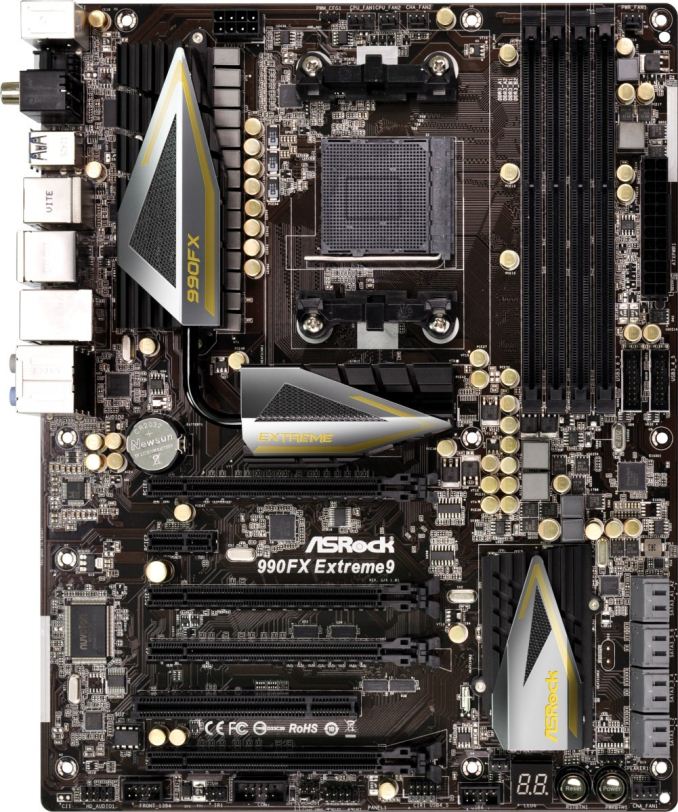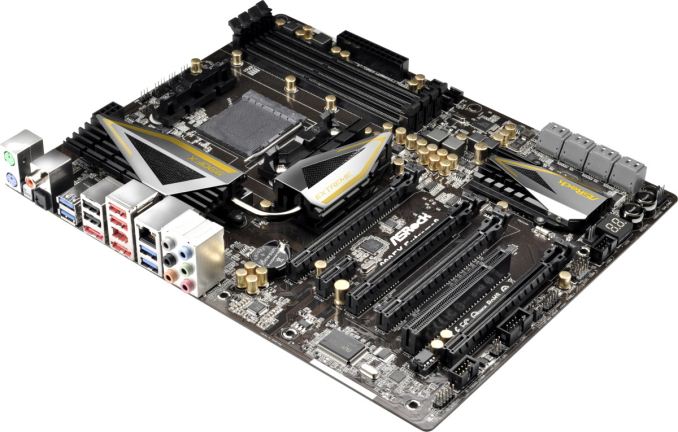AMD’s 5 GHz Turbo CPU in Retail: The FX-9590 and ASRock 990FX Extreme9 Review
by Ian Cutress on August 9, 2014 8:00 AM ESTFor new users to the PC industry, or those that migrated towards newer APU platforms, it is worth going back and recalling the AM3+ socket with the 990FX chipset. When the platform was released, it offered several advantages that Intel lacked at the time: a full set of SATA 6 Gbps ports was the main advantage which took Intel another two generations to offer. The chipset, with the right CPU, also offered substantially more PCIe lanes than the mainstream Intel parts which were similarly priced. While the user could have sixteen PCIe 2.0 lanes from an Intel CPU for graphics coupled with eight PCIe 2.0 lanes from the chipset, AMD users had 32 PCIe 2.0 lanes from the CPU for graphics, another six PCIe 2.0 x1 lanes for controllers and four PCIe 2.0 x1 lanes from the chipset. This gave the AMD motherboard manufacturers more bandwidth to add extra ports or adjust their PCIe layout for graphics. Note that this is the latest AMD platform to support SLI, rather than the newer FM1/FM2 platforms that do not.
There are a few limitations on the 990FX chipset worth mentioning. When this motherboard we are testing today was released, PCIe 3.0 was gaining momentum. The only way to add PCIe 3.0 to these motherboards was to integrate a PLX chip between the Northbridge and the GPUs which gave PCIe 3.0 capabilities between the GPUs, but it still limited data transfer between the PLX chip and the CPU to PCIe 2.0. The other limitation was one of cost. AMD platforms have historically been low cost markets, at least for end users, which correlates to a reluctance to expand spending on motherboards. This reduces the market for high end motherboard solutions which might incorporate extra features and controllers, and as a result many AM3+ motherboards were aimed at price/performance rather than feature set.
The ASRock 990FX Extreme9 sits near the top of the stack for feature set, and currently retails for $170. To put that into perspective, we discuss $170 motherboards for Intel’s latest chipsets as a mid-range point rather than the high end.
Also worth noting that because our last 990FX reviews were with the FX-8150 processor, in order to compare to historical data we also used the Extreme9 with the FX-8150 for comparison points.
ASRock 990FX Extreme9 Overview
Visual Inspection
Taking the motherboard out of the box for the first time and there are several items worth noting. Firstly the extended heatsink which covers the 12+2 phase power delivery to the side of the socket and the North Bridge just below the socket. ASRock has placed all the power delivery chokes in a line, and uses a CHIL8328 IC for a digital design. This PWM controller powers 6-8 phases, and thus the system uses multiplexing to get the desired 12 for the CPU voltage.
The socket area has four fan headers within immediate reach – two CPU and one chassis header directly above the socket, and a 3-pin PWR header to the top right of the DRAM slots. The other two fan headers on the motherboard are located at the bottom, one to the left of the 2-digit debug and the other to the right of the power/reset buttons. The socket area uses a low heatsink profile combined with a gap to the DRAM that should allow for large air coolers to be used.
The DRAM slots use double sided latch mechanisms and there is ample space to the first major PCIe slot. At the bottom of the DRAM slots, to the right, are two USB 3.0 headers from an Etron EJ188H controller. At the time this motherboard was made, a chassis may have had one USB 3.0 header, and thus ASRock also includes a USB 3.0 panel in the box.
Underneath this are eight SATA 6 Gbps ports, the top two from an ASMedia ASM1061 controller followed by six from the south bridge. In this situation, with an additional controller, I would have preferred if ASRock had used a different color for the ASMedia ports. Below these is a fan header, the power and reset buttons, and the two-digit debug.
At the bottom of the motherboard is an IEEE1394 header, a COM header, two USB 2.0 headers, an IR header and the front panel headers. Above this is the odd PCIe layout, which combines the 32 PCIe 2.0 lanes from the north bridge with another PCIe 2.0 x4.
The layout is such that the top PCIe slot is an x16, followed by an x1. The second full length slot is a PCIe 2.0 x4, followed by another PCIe 2.0 x16. This slot shares bandwidth with the bottom PCIe slot, whereby if the bottom is populated, they both go to PCIe 2.0 x8. There is also a PCI slot near the bottom.
This means:
Configuration 1: x16/x1/x4/x16/PCI/-
Configuration 2: x16/x1/x4/x8/PCI/x8
Having this layout allows the user to equip the board with three GPUs in the first, third and fourth full length slots. If they are double slot cards, the PCIe 2.0 x4 is left vacant for a sound card, network card, RAID card or other PCIe device. It is worth noting that in terms of audio, ASRock has equipped this motherboard with a Realtek ALC898 codec.
The rear panel uses two PS/2 ports, one for mouse and one for keyboard, followed by a ClearCMOS button and SPDIF outputs. The four blue USB 3.0 ports are powered by another Etron EJ188H controller, and the panel also has four USB 2.0 ports with two eSATA 6 Gbps ports. The IEEE1394 port on the rear is perhaps one of the last consumer oriented motherboard to have this port pre-installed. The Intel NIC on the rear IO might seem a little strange on an AMD motherboard, but this is one of the top line 990FX solutions. The audio jacks round off the set.
Board Features
| Board Features | |
| Price | US (Newegg) |
| Size | ATX |
| CPU Interface | Socket AM3+ |
| Chipset | 990FX + SB950 |
| Memory Slots |
Four DDR3 DIMM slots supporting up to 32 GB Up to Dual Channel, 1066-2450 MHz |
| Video Outputs | None |
| Onboard LAN | Intel 82583V |
| Onboard Audio | Realtek ALC898 |
| Expansion Slots |
3 x PCIe 2.0 x16 (x16/x16/- or x16/x8/x8) 1 x PCIe 2.0 x4 1 x PCIe 2.0 x1 1 x PCI |
| Onboard SATA/RAID |
6 x SATA 6 Gbps (Chipset), RAID 0,1,5,10 2 x SATA 6 Gbps (ASMedia ASM1061) |
| USB 3.0 |
4 x Rear USB 3.0 (Etron EJ188H) 2 x USB 3.0 Headers (Etron EJ188H) |
| Onboard |
8 x SATA 6 Gbps Ports 2 x USB 3.0 Headers 2 x USB 2.0 Headers 6 x Fan Headers 1 x COM Header Power/Reset Switches Dr. Debug LED Front Panel Connector Front Audio Connector |
| Power Connectors |
1 x 24-pin ATX 1 x 8-pin CPU |
| Fan Headers |
2 x CPU (4-pin, 3-pin) 3 x CHA (4-pin, 2x 3-pin) 1 x PWR (3-pin) |
| IO Panel |
1 x PS/2 Keyboard 1 x PS/2 Mouse 4 x USB 2.0 4 x USB 3.0 2 x eSATA 6 Gbps 1 x IEEE1394 1 x Intel NIC Clear CMOS Switch Audio Jacks |
| Warranty Period | 3 Years |
| Product Page | Link |
If we were making a high end AMD motherboard for 2014, the extra lanes would be perfect for PCIe storage. Pile on a SATA Express and M.2 x4 slot without losing lanes to other functions. Some native USB 3.0 would be nice, or 3.1 via controllers. PCIe 3.0 support would be a must of course, along with a Realtek ALC1150 or more advanced audio codec. ASRock’s latest motherboards have featured a water-proof/superhydrophobic coating, or small LCD panels to aid in overclocks, which might be something in AMD meets 2014.















146 Comments
View All Comments
just4U - Sunday, August 10, 2014 - link
In my opinion the best cpu AMD has right now is A8 7600 coming in at $120 CAD. I see no reason to go Intel i3 as long as that puppy is there. (A argument can be made for Intel's AE 3x) The downside for AMD is I also see no reason why anyone should buy a more expensive CPU/APU from them.. their A-10 is priced in the same range as lower I5's which is a bit of a head shaker and their AM3+ is getting long in the tooth with no refresh.I could see a new FM2+ FX branded cpu priced at the tier their offering their A-10s for as it would bring something more to the table.. but they do really have to do something about single threaded performance. Even if it wasn't being used as much in programs their line-up takes a beating in reviews which is bad optics for them and leads to people like us (who read these things..) to suggest other alternatives for people buying/building a system.
FightApathy - Sunday, August 10, 2014 - link
237W operational power consumption. This is just.... terrible for a 2014 CPU. And what is even worse, is that i7 with 1/3 of TDP performs as well or even better. AMD has to stick to APUs.KAlmquist - Sunday, August 10, 2014 - link
"One could speculate that releasing the next generation of FX-85xx might put them behind the FX-9590 in performance, or that the fabrication process was not suitable for a quad-module CPU with the new architecture improvements."According to the Steamroller review, the 28nm bulk process that Steamroller was designed for won't clock as high as the 32nm SOI process that Piledriver uses. So an 8 core Steamroller processor would execute more instructions per clock, but would be clocked at least 400 Mhz slower, and as a result would be only marginally faster than Piledriver.
AMD is expecting to achieve another boost in instructions per clock with Excavator, but unless something has changed they plan to synthesize Excavator using software that minimizes die area at the cost of clock speed, so I'd expect Excavator to do more to improve performance per watt than to improve absolute performance.
After Excavator comes a completely new design, which we can hope will be a major improvement over the bulldozer derivatives.
mathewmichal7 - Sunday, August 10, 2014 - link
Draft your credit agreement is an excellent example of an innovative style of marketing. There is a provision for the lender to get cash advance check their debtors. He takes comfort in check on the day of your salary. Undoubtedly reduces the possibility of non-payment money and is beneficial for the creditor and the debtor. Delinquent and insolvent are not left disappointed by the money lenders. Your loan application forms become a matter of serious consideration if they manage to impress your money lenders for their current financial situation. The number of your credit profile does not control the situation and creditor left unchecked.http://www.12monthloansmoney.co.uk
duploxxx - Monday, August 11, 2014 - link
funny to read all these replies. makes you wonder what avarage age and technology knowledge is of these tech sites.....All complaining about useless AMD and process tech but yet they don't understand that these own consumers are the ones to blame, they buy the jingle and bells and the marketing buzz... recent review on anandtech showed enough what was best to buy, yet most decide to buy the other marketing dominant brand as if there all day tasks are faster since the benchmarks show few percentage faster finished task... buyers need to blame themselve for there own stupid decisions. Want a fast system? get rid of Microsoft garbage. OEM-marketing kill the competition and consumers are the victim but they still dont understand it. (useless chipset revisions, socket changes, design rules like in ultrabook space and centrino, etc, etc..). poor consumers.
From a tech site you indeed need to review such a CPU, its mandatory but i don't think it gets the honor for what it supposed to be, anyhow there will be only few to sell since it has no reason to exist becide the mythical part.
I remember the days of pentium D and extreme, no reason at all to exist yet 1000's of buyers just for the brand....
duploxxx - Monday, August 11, 2014 - link
since no edit button :) thx anandtech asking that already for more then 10yI meant age and knowledge of the readers of course
Klimax - Monday, August 11, 2014 - link
Lovely nonsensical post. Including out of date bashing of Microsoft. 90s called, they want your nonsense back.Mugur - Monday, August 11, 2014 - link
There is still room for AMD in my home. I have 2 SB Core i3s for the gaming machines and I've just replaced an 80W Phenom II HTPC with an Intel NUC 2820. But my server (currently an Athlon II X4) will be soon an A10-7800 at 45W on a FM2+ with 8 SATA board...jgarcows - Monday, August 11, 2014 - link
How did you manage to post a review of a chip with a bundled retail liquid cooling system and not post a single picture of the liquid cooling system? How easy was it to install, what size openings are needed on the case, etc...LemmingOverlord - Monday, August 11, 2014 - link
May I suggest:a) some impressions on the liquid cooling? (+pics)
b) underclocking the CPU (and lowering voltage), then map that to power v. performance curves for the same set of benchmarks you ran... just to see how big a drop it would be in wattage.